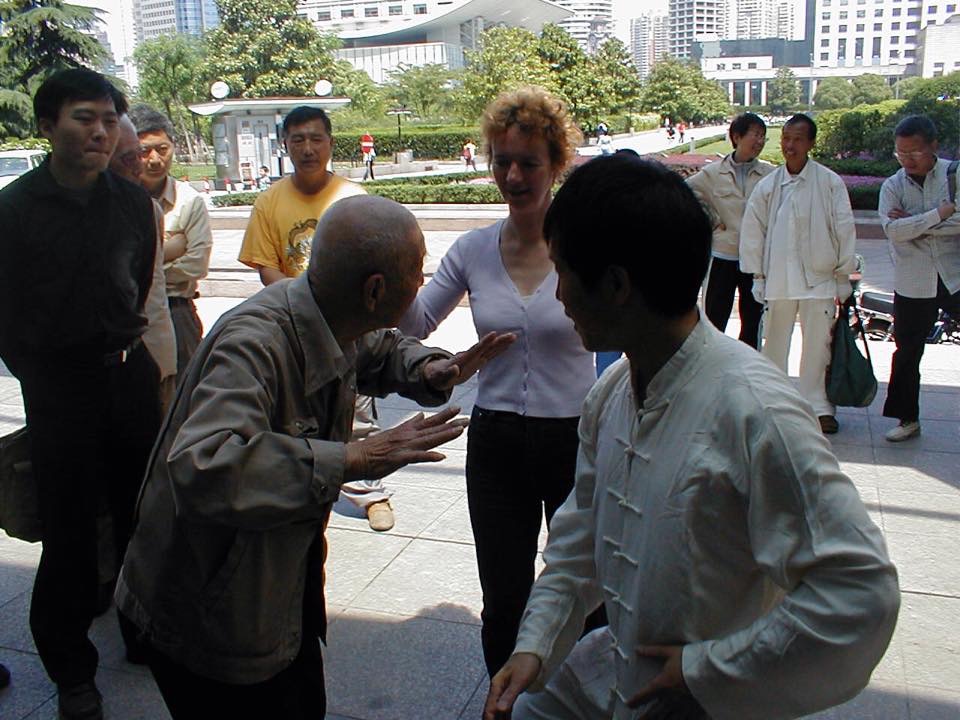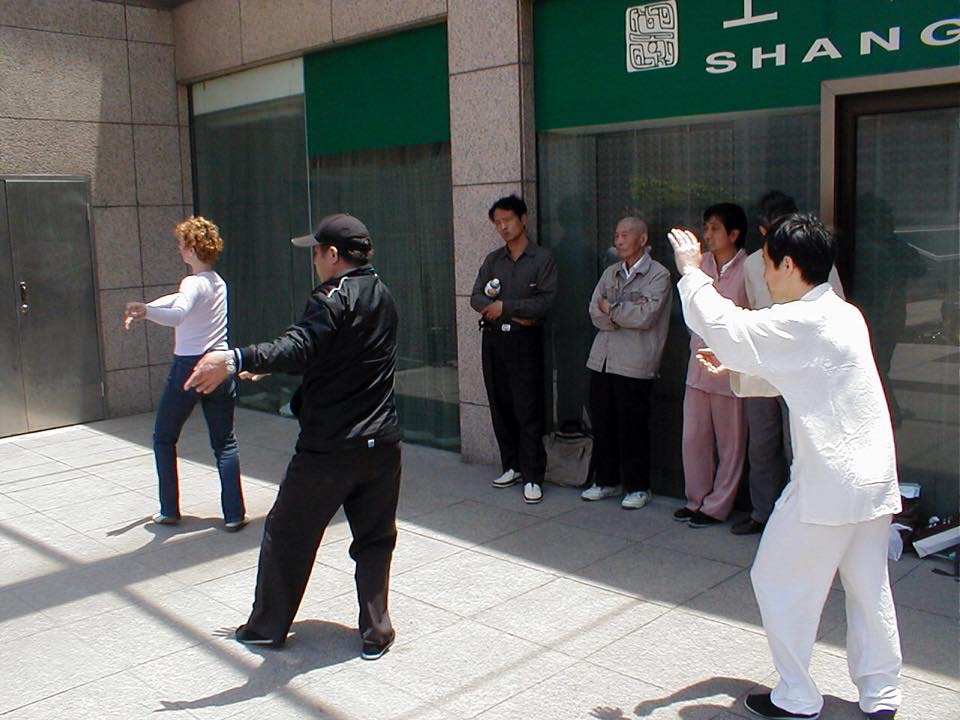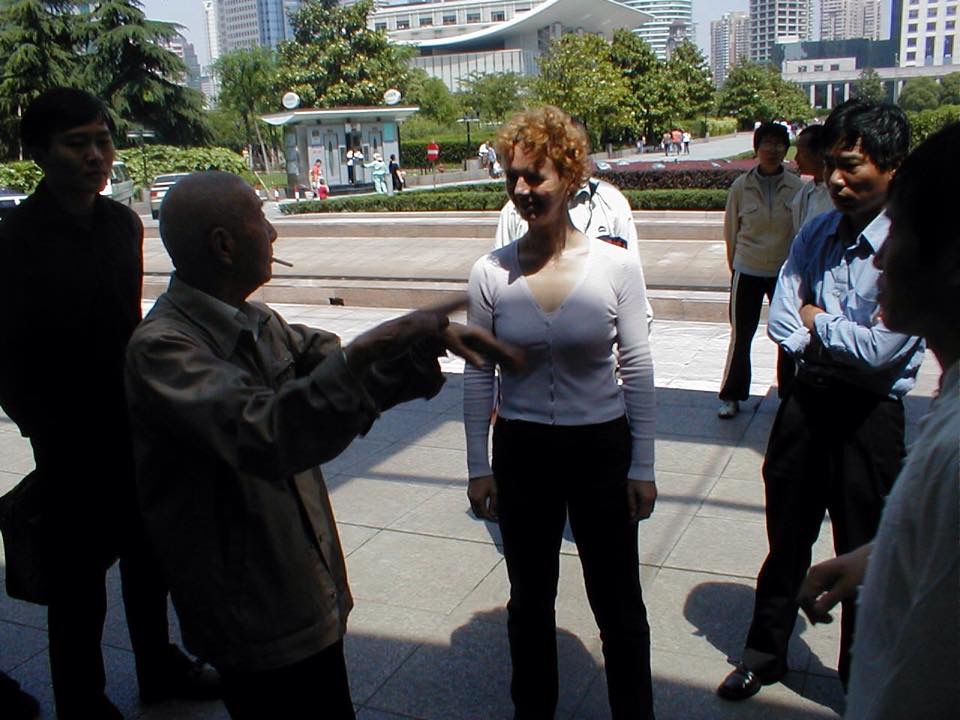Foundation Work & Theories for Taiji Quan Practice
1. Dantian Exercises:
Dantian exercises are essential to cultivate and concentrate vital energy and pre-natal qi.
The type of exercises practiced, particularly in the Wu Style, include a variety of rotational exercises in various directions, hugging the leg and knee to the chest and body, which helps to save and store the qi (energy) to the dantian.
Dantian exercises are akin to saving money in the bank and by practising the exercises regularly, one is increasing the interest rate and getting a higher return on one’s original investment.
As our vital energy is constantly being expended through our everyday activities, walking, working, communicating, bustling around etc, we also need to constantly replenish it. For example, as we walk, we lose energy through our energy centres, like the bubbling well, so we need to restock our energy banks with energy cultivation work.
By practising dantian exercises, we are also stimulating and exercising our waists, spines and centre, as by the turning of the dantian we also help activate the waist area and other joints of the spine in unison, which helps to loosen and relax the joints, eliminating tension and blockages, plus help allow the free flow of energy through the centre channels, including the governing and conceptual vessels. After stimulating and exercising the dantian, we should also close and recentre with some standing meditative postures and “praying” type standing postures, to help concentrate and store the energy back to the dantian in a tranquil state, ready for use when needed.
There are several postures from Master Dong Bin’s set of basic foundation exercises that achieve this effect.
One is the double handed waist-holding posture, with the palms resting on the Mingmen area, fingers pointing straight down and the side edges of the palms touching each other, standing in a high horse stance; the other is the same posture, but held in a bow stance. Both these exercises help to focus the energy to the mingmen and dantian, integrating the internal power and energy of the dantian and the structural elements and power of the waist, letting tension drop down out of the structural supports of the shoulders and letting the power flow down into the ground, leaving the energy concentrated in the dantian.

Master Dong explaining the interaction of the Dantian & Mingmen
2. Opening the Joints & Elongating the Tendons:
Before exercising the form, traditionally the masters would teach their students a variety of exercises designed to open and relax the body, to allow not only the energy to flow freely, but also the intention and ultimately the power.
If the body is tight and closed, due to muscle, ligament, tendon or joint tension and blockage, there is no way that the energy and power can be transmitted freely, smoothly and powerfully and thus the power applied to the opponent will be negated, decreased, not uniform and insufficient. To enable the body to open, there are a variety of elongation and opening basic foundation exercises that the ancient masters recommended.
In fact Master Dong Bin stated that his main teachers, Dong Shi Zuo (in particular) and Yue Huan Zhi taught a set of exercises that filled this task to such an extent, that up until the age of 88, Master Dong Bin (who was of a very slight build) could still drop down into his hips and squat down with his bottom almost touching the ground, with his back perfectly straight and aligned, and rise up without using his legs muscles to push up, purely using the energy synapses and joints folding and springing open. This allowed the power to simply flush through the body, and not only carried, but also bounced the opponent away with the flow!
To develop this kind of power and openness and to make each part of the body work in harmony, every part of the body’s energy, power and structure must be evenly distributed, so that there is no one area, working less or more than another.
Master Dong practiced a double single whip posture, with both arms outstretched to the sides at shoulder height, with the palms angled outwards away from the body to the sides and slightly forwards, thus stretching and releasing the tension in the arms, shoulders, ribs and spine, standing in a high horse stance.
Grandmaster Dong Ying Jie also once explained to his disciples Yue Huan Zhi and Dong Shi Zuo, that male students needed to practice and mimic the softness, relaxation, gentleness and fluidity of women, whereas female students needed to practise the power and body integration and cultivate the body mass of men.
Both genders needed to open and stretch the body to develop it into an integrated whole, whilst still working on the above principles to help soften and reduce men’s reliance on their inherent strength and develop women’s power.

Rose & Wang Ming Bo training under Master Dong Bin’s watchful eye
3. Power, Energy & Intention Cultivation:
Master Dong’s “Phoenix Flying Exercise” is an exercise that helps to integrate the upper, lower, left and right quadrants of the body, helping to unify the body’s power, but at the same time, the nature of the exercise is to utilize the imagination and intention and thus activate the energy within the movement, rather than purely exercise the physical aspects.
The exercise helps to move the body’s centre, as the movements are channelled through the spine and central energy channel and thus help to break down the tension in the body, allowing free flow of energy throughout, therefore breaking down the “double-weightedness” which tends to restrict and block the whole body’s energy from being utilized.
If the spine and centre are unable to differentiate between each of the vertebrae, on all sides and through the centre, then the spine and thus the dantian are one block, which is double-weighted, not yin and yang in harmony (阴阳相济).
This exercise opens the spine, (the Chinese meaning for the word open means relax and gain full utelage of the area) just like a cat’s spine is able to move fluidly, smoothly, evenly, sequentially, independently and powerfully in all directions and with inherent, relaxed grace and power. This is the idea and state we seek to acquire for our own spines within our Taiji practice.

Discussion of using the waist and intention
4. Breathing:
When performing the form, the breathing and yin/yang interchanges of the mind, intention, spirit, energy and power are clearly differentiated and demarcated, to ensure proper applicatory usage and utilization of the whole body’s power.
Inhaling: When inhaling, the mind and spirit (心 & 神) are gathering and concentrating, or as they say in Chinese “He – 合” which is often translated as “Closing”, but can also represent gathering and concentrating.
Simuntaneously, the central energy and intention (中气 & 意) are expanding and opening, or as they say in Chinese “Kai – 开” which is often translated as “Opening”, but can also represent expanding and encompassing.
In terms of the yin/yang differentiation with regard to the physical structure, the hands and feet are “Yang 阳 – Gang 刚”, this means they have the yang quality of “hardness” or power inherent.
This translation of “hardness” for the word “Gang” in Chinese, does not mean that the hands and feet are tense or stiff, rather it implies the power is inherent and encapsulated within, not apparent by the feeling of stiffness or hardness to the touch, but more like the kind of “hardness or power” that a tiger’s paw has.
When one is touching or in contact with the opponent, the feel of your hands on them should still feel soft and relaxed, but simultaneously the power inherent in the hands shouldn’t be reduced or collapsed, or feel like it’s lost contact with the opponent, otherwise the power collapses and you become “diu – 丢” or “lost”, so that then there is no power that can be transmitted or discharged.
When a person’s power is “lost”, is when people have to resort to using brute strength or muscular, structural power to deflect an opponent, as they have cut off their own energy and internal power.
For the feet, the feeling is exactly the same. They should not be “screwed” into the ground or pressing stiffly into the earth in a tense and hard, one-dimensionally flat way, rather they should feel that they “cover” the earth in an “energy” strong stance, more like as an animal is in contact with the earth, as in a tiger stalking; not like a physical block or object, such as a heavy piece of furniture placed on the ground. If one can attain the correct sensation for the hands and feet, this way the opponent cannot feel through the contact points of the hands and feet or through your positioning of your stance etc, that you are preparing to strike or “Fa jing – 发劲” or transmit/discharge energy and power.
In terms of the waist and dantian, the waist needs to remain soft and pliable or “rou – 柔”. This being the yin “阴” counterpart of the “Yang – Gang” element of the hands and feet. The waist is expanding and gathering, whilst remaining soft, relaxed, pliable and supple; it can harness and concentrate the power to its core, rather like the way a cat will gather all of its power to its spine as it prepares to pounce from a crouching or stalking posture.
Simultaneously, the movements of the spine harnessing and concentrating the power are not felt through the contact points or extremities of the hands and feet, thus the opponent is blissfully unaware of the gathering storm that is about to be released onto them until they feel it shatter through, much like a lightening strike into their body. They are unable to counteract or prepare to defend against this kind of power, because they never felt the person signal it to them by the stiffening or hardening of the contact points or through the person’s body or outer expression.
This is the quality of “Fa jing”, not a physical push or shove and it is not detected by tension or stiffness in the hands or body. The Chinese word for “Fa -发” is used to mean “transmit, release or discharge”, in relation to radio waves or signals, such as we have in mobile phones and radio signals, it is more an abstract kind of transmission of energy, not an outward, obvious physical force.
We can liken the energetic quality of gathering power to the essence of Fire, from the Five Elements, that is when the outside of the fire touches the surface of an object it burns, ie. Fire releases its power, but fire’s inside is empty “Xu – 虚” or intangible, not solid or tense ”solid – 实”, so our body and energy also tries to mimic this intangible quality.
Likewise, our extremities deliver the power to the opponent, whilst remaining soft and relaxed and our inner centre, whilst gathering power never feels solid or tense.
Exhaling: Here the opposite situation arises; the shen/spirit and heart-mind/xin are opening and the intention/yi and qi/energy are gathering and concentrating.
The hands and feet or extremities are now soft/rou not tense, so as to allow the discharge of power to pass through them like transmission devices; they still allow no signal to be passed to the opponent by becoming hard or tense and when we strike and discharge energy, they never signal their intention by applying force by themselves.
In Chinese they say “the contact points themselves do not apply force or become hard and don’t attempt to apply power by themselves” – “jie chu dian bu da ren – 接触点不打人”.
The waist needs to be plumb erect, so as to engage the full, sequential power of the whole spine and allow it to transmit power evenly and equally to the extremities and thus the opponent.
The waist now has the Yang quality of “Gang”, or powerful, and it needs to energetically and with mind-intent enter the opponent’s space, releasing the power harnessed like the quality of water.
Meaning that the discharge of power must mimic the power and essence of water, that is when water from a river or sea etc, overflows its banks and sweeps all before it in a flood; there is no precise direction or one-dimensional quality to its power, rather it’s uniform in its distribution of power and energy and carries everything away along with its force.
Taken from Master Yue Huan Zhi’s treatise on Taiji’s Inner Principles.
Interpreted and translated by Master Wang Ming Bo & Rose Oliver.
